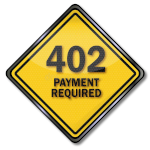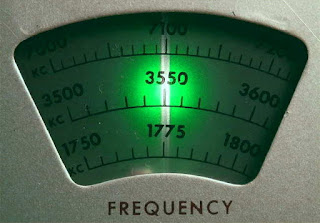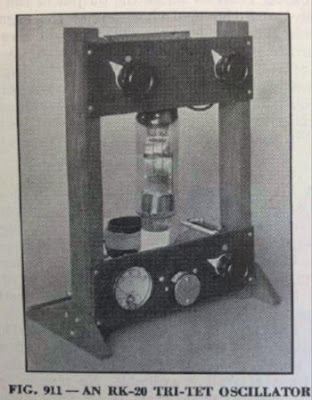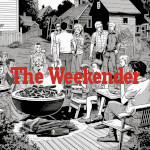 Hunting For NDBs In CLE266
Hunting For NDBs In CLE266
Propagation on MF has been both hot and cold for the past few weeks, seemingly depending on where you live and the amount of geomagnetic activity affecting your region.
A 'challenge target' for listeners in North America is YZS - 362kHz in Coral Harbour, NU, on Southampton Island at the north end of Hudson Bay. It's widely heard throughout North America and Europe and is a good target for listeners everywhere. Listen for YZS's upper sideband on 362.405 kHz.
When tuning for NDBs, put your receiver in the CW mode and listen for the NDB's CW identifier, repeated every few seconds. Listen for U.S. NDB identifiers approximately 1 kHz higher or lower than the published transmitted frequency since these beacons are modulated with a 1020 Hz tone approximately.
For example, 'AA' near Fargo, ND, transmits on 365 kHz and its upper sideband CW identifier is tuned at 366.025 kHz while its lower sideband CW ident can be tuned at 363.946 kHz. Its USB tone is actually 1025 Hz while its LSB tone is 1054 Hz.
Often, one sideband will be much stronger than the other so if you don't hear the first one, try listening on the other sideband.
Canadian NDBs normally have an USB tone only, usually very close to 400 Hz. They also have a long dash (keydown) following the CW identifier.
All NDBs heard in North America will be listed in the RNA database (updated daily) while those heard in Europe may be found in the REU database. Beacons heard outside of these regions will be found in the RWW database. These databases have recently been re-vamped and are slicker than ever before!
From CLE coordinator Brian Keyte (G3SIA), comes the following CLE info:
Hello all
Our 266th Co-ordinated Listening Event is almost here.
Can new 'listening eventers' join in too? YES, PLEASE!
Joachim and I are always pleased to help first-time CLE logs
through the harvester program.
Days: Friday 26 March - Monday 29 March
Times: Start and End at midday, your LOCAL time
Range: 350.0 - 369.9 kHz
Please log all the NDBs you can identify that are listed in this range (it includes 350 kHz but not 370) plus any UNIDs that you come across there.
You can find full information to help you, including seeklists made from
REU/RNA/RWW, by going to the CLE page http://www.ndblist.info/cle.htm and clicking on CLE SEEKLIST there.
Please send your 'Final' CLE log to the List, if possible as a plain text
email and not in an attachment and - important - with 'CLE266' and 'FINAL'
in its title.
Please show the following main items FIRST on EVERY line of your log:
# The full Date (e.g. 2021-03-26) or just the day (e.g. 26)
and UTC (the day changes at 00:00 UTC).
Many of us will be changing our house clocks during
the weekend, but UTC CONTINUES UNCHANGED.
# kHz - the beacon's nominal published frequency, if you know it.
# The Call Ident.
Optional details such as Location and Distance go LATER in the same line.
Please always include details of your own location and brief details of the
receiver, aerial(s) and any other equipment you were using.
Joachim or I will send the usual 'Any More Logs?' email at about 19:00 UTC
on Tuesday so you can check that your log has been found OK.
Make sure that your log has arrived at the very latest by 08:00 UTC on
Wednesday 31 March. We hope to make all the combined results within a day
or so.
Good listening
Brian
-------------------------------------------------------------------
From: Brian Keyte G3SIA ndbcle'at'gmail.com
Location: Surrey, SE England (CLE coordinator)
-------------------------------------------------------------------
If you are interested in some remote listening - maybe due to local difficulties - you could use any one remote receiver for your loggings, stating its location and with the owner's permission if required.( e.g. see kiwisdr.com ) A remote listener may NOT also use another receiver, local or remote, to make more loggings for the same CLE.
These listening events serve several purposes. They
• determine, worldwide, which beacons are out-of-service or have gone silent since the last CLE covering this range
• will indicate the state of propagation conditions at the various participant locations
• will give you an indication of how well your LF/MF receiving system is working
• give participants a fun yet challenging activity to keep their listening skills honed
Final details can be found at the NDB List website, and worldwide results, for every participant, will be posted there a few days after the event.
The NDB List Group is a great place to learn more about the 'Art of NDB DXing' or to meet other DXers in your region. There is a lot of good information available there and new members are always very welcome. As well, you can follow the results of other CLE participants from night to night as propagation is always an active topic of discussion.
You need not be an NDB List member to participate in the CLEs and all reports, no matter how small, are of much value to the organizers.
Remember - 'First-time' logs are always VERY welcome!
Reports may be sent to the NDB List Group or e-mailed to CLE co-ordinator, Brian Keyte (G3SIA), whose address appears above. If you are a member of the group, all final results will also be e-mailed and posted there.
Please ... give the CLE a try ... then let us know what NDB's can be heard from your location! Your report can then be added to the worldwide database to help keep it up-to-date.
Have fun and good hunting!
Steve McDonald, VE7SL, is a regular contributor to AmateurRadio.com and writes from British Columbia, Canada. Contact him at [email protected].
 Looking at VHF/UHF SOTA Data
Looking at VHF/UHF SOTA Data
On Twitter, someone recently commented that it would be nice to have more 2m SSB activity for Summits On The Air (SOTA). It is well known that FM is a more commonly used mode but that its performance suffers for weak signals. This got me wondering about which bands and modes are being used for SOTA above 50 MHz.
Above and Below 50 MHz
First off, I wondered what portion of SOTA radio contacts are on VHF/UHF. Looking at the SOTA database Facts and Figures page, I simply grouped the number of QSOs as “Above 50 MHz” and “Below 50 MHz.”
| Frequency | QSOs | % of Total |
| Above 50 | 1346206 | 21% |
| Below 50 | 5144547 | 79% |
| Total | 6490753 | 100% |
So we can see that about 1/5th of the SOTA QSOs are done using VHF and higher frequencies. Certainly, we’d expect that the HF bands would dominate the total but this VHF+ percentage is higher than I expected.
Breaking Down > 50MHz
That leads to the question of what bands are used above 50 MHz? The table below shows the >50 MHz data broken out by band. The % of Total column indicates the percent of all QSOs (Above and Below 50 MHz), while the % of >50 MHz column shows the percentage relative to only >50 MHz radio contacts. Simply put, the % of Total column will sum to 21%, matching the number in the first table. The % of >50 MHz column sums to 100%.
| Frequency | QSOs | % of Total | % of >50 MHz |
| 50MHZ : | 48035 | 0.74% | 3.57% |
| 70MHZ : | 10921 | 0.17% | 0.81% |
| 144MHZ : | 1202311 | 18.5% | 89.3% |
| 220MHz : | 1064 | 0.02% | 0.08% |
| 433MHZ : | 126202 | 1.94% | 9.37% |
| 900MHz : | 204 | 0.00% | 0.02% |
| 1240MHZ : | 12526 | 0.19% | 0.93% |
| 2.3GHZ : | 1554 | 0.02% | 0.12% |
| 3.4GHz : | 142 | 0.00% | 0.01% |
| 5.6GHZ : | 468 | 0.01% | 0.03% |
| 10GHZ : | 1186 | 0.02% | 0.09% |
| 24GHZ : | 167 | 0.00% | 0.01% |
| Microwave : | 382 | 0.01% | 0.03% |
Well, it doesn’t take a degree in statistics to see that the 144 MHz band (2 meters) is the most popular VHF/UHF band for SOTA. Almost 90% of the QSOs are on this band. The next most used band is 433 MHz (70 cm) at a little over 9%. The 6m band (50 MHz) comes in at third with about 3.5%. The other bands are so small, they don’t really add much to the total.
The data on the SOTA page does not break out mode used by band but it does provide some aggregate mode numbers. The number of FM contacts (using any band) is 1186542. It is reasonable to assume that almost all of these FM QSOs were made above 50 MHz. (FM is used a bit on the 10m band but that combination is rare in SOTA.) That means, for frequencies >50 MHz, 88% of the QSOs (186542/1346206) were completed using FM. We don’t know how the remaining 12% splits out but I would expect them to be a mix of SSB and CW, but dominated by SSB.
Given the high number of 144 MHz contacts in the mix, it is safe to say that 2m FM is the dominant mode for VHF/UHF SOTA. After all, it is The Utility Mode. The reasons are obvious…almost every radio ham has a handheld transceiver that can do 2m FM. It makes for an easy way to get on the air and active a summit. More importantly, it is an easy way to chase a summit. When I plan a SOTA activation, I think about the kinds of operators that will be within range and what kind of gear they are likely to have. It does me no good to drag along equipment for 2m SSB/CW if there is no one around to work that band/mode.
This analysis does confirm that the number of non-FM QSOs on VHF/UHF is relatively small. The 12% of non-FM QSOs above 50 MHz corresponds to only 2.5% of all SOTA QSOs. So why is this? Clearly, the affordability and popularity of the FM handheld transceiver is a big factor. There are portable radios that can do “all modes” on VHF/UHF such as the Elecraft KX3 (2m option), Yaesu FT-818, and the Icom IC-705, but these are much more expensive.
What About 70cm and 6m?
Now, it is interesting that the 70cm numbers are small compared to 2m. Many of those handheld transceivers that get used for 2m also have 70cm included, so you might expect there to be more 70cm QSOs in the mix. For a given boom length, a 70 cm Yagi antenna will have more gain than a 2m Yagi. So gain is easier to come by on the higher band.
Note that the SOTA rules do not encourage working the same station on more than one band. You only get credit for working a station once on an activation. (Compare this to VHF contest scoring which usually adds in additional credit for working stations on multiple bands.) So if a chaser works someone on 2m, they typically don’t bother working them on other bands. I am not saying this is bad, I am just trying to explain why we don’t see more QSOs on 70cm.
The other band you might expect to see more activity is 50 MHz (6 meters). This band is available to Technicians in the US and, when the band opens up, you can easily work a thousand miles or more via Sporadic-e propagation. (Sometimes F-layer propagation, too, but we’ll need a whole bunch more solar activity for that to happen.) Many HF rigs include 6m as a “bonus band”, even some of the QRP radios popular with the SOTA crowd (KX3, IC-705, etc.) So why are the 6m numbers so low? This band offers a metric ton of fun, but it dishes it out randomly. There is a reason they call it the Magic Band…sometimes the Magic is there and sometimes it is dead quiet. When it’s dead quiet, it is a poor imitation of the 2m band. It also requires larger antennas, so if an activator decides to use antenna gain to help their signal, a portable Yagi for 2 meters is going to be a lot handier than one for 6 meters.
CW and SSB
This data does show that CW and SSB are lightly used for SOTA on the VHF/UHF bands. This is an opportunity. If more of us used these modes, it would improve our ability to squeeze out contacts when the signals are weak.
Bob K0NR
The post Looking at VHF/UHF SOTA Data appeared first on The KØNR Radio Site.
Bob Witte, KØNR, is a regular contributor to AmateurRadio.com and writes from Colorado, USA. Contact him at [email protected].
 LHS Episode #402: Payment Required
LHS Episode #402: Payment Required
Hello and welcome to the 402nd installment of Linux in the Ham Shack. In this episode, the hosts start by wrapping up the most recent QSO Today Virtual Ham Expo. Afterwards, discussion topics range from in-person ham radio events that are (currently) still happening to Garuda Linux, Audacity, Kooha, Raspberry Pi pico SDRs and much more. Thank you for listening we hope you have a fantastic week.
73 de The LHS Crew
Russ Woodman, K5TUX, co-hosts the Linux in the Ham Shack podcast which is available for download in both MP3 and OGG audio format. Contact him at [email protected].
 Introducing AmateurLogic Shorts
Introducing AmateurLogic Shorts
Introducing AmateurLogic Shorts.
In additional to our regular AmateurLogic.TV and Ham College episodes each month, look for the new AmateurLogic Shorts every other week on the AmateurLogic.TV YouTube channel.
In this first episode Emile covers “Getting The Most From Your Internet Connection.”
Please Subscribe and click the Like and Share buttons if you enjoy our content.
Note AmateurLogic Shorts are only available on YouTube.
George Thomas, W5JDX, is co-host of AmateurLogic.TV, an original amateur radio video program hosted by George Thomas (W5JDX), Tommy Martin (N5ZNO), Peter Berrett (VK3PB), and Emile Diodene (KE5QKR). Contact him at [email protected].
 My 2021 Novice Rig Roundup Summary
My 2021 Novice Rig Roundup Summary
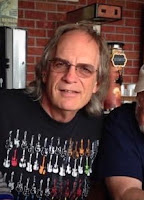 |
| Bry - AF4K (SK) |
Missing for the first time was NRR co-founder, Bry Carling, AF4K, who sadly became a silent key last year. I missed hearing him and always looked forward to the challenge of making it down to Florida from here. This year''s NRR was dedicated to AF4K - RIP Bry.
Some of this year’s excitement included the much better conditions on 15m over the previous solar-low years. The band benefited from an increase in the solar flux at the beginning of the week which kept the MUF a little higher than 21MHz for most of the Roundup.
It was particularly exciting to hook-up with VA1RST way back in Nova Scotia, on 15m. His little DX-60 did a good job in making the coast-to-coast leap at 559.
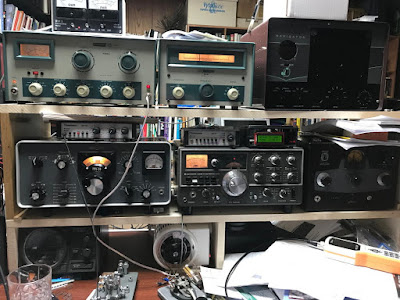 |
| VA1RST in Nova Scotia |
I think this year I heard more DX-60s than ever before! A couple of years ago it was the Knight T-60 that seemed to be everywhere. Don’t pass up either of these fine NRR rigs should you be fortunate enough to run across one.
All told, I completed 26 NRR contacts on 15m which surely is good news for future NRRs going into Cycle 25. If the bold predictions for the new cycle come to fruition, we may be enjoying 10m next time out as well!
My first contact on 15m was with Mike, WA5POK in TN, who came blasting through at 599 with his DX-40 only to have the power transformer in his National NC-270 go up in smoke a few days later. Such are the perils of living life on the edge, in the NRR!
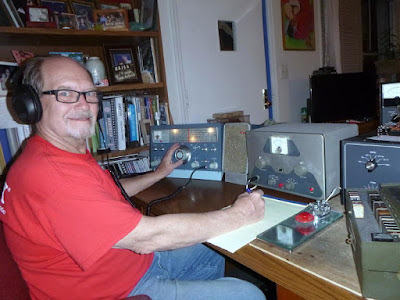 |
| Mike - WA5POK in Tennessee |
I was lucky enough to snag Rich, WB2WGX in NY on 15m for his only contact on that band! I'm not sure why he didn't find more action as his Ranger II was 599 here on the west coast.
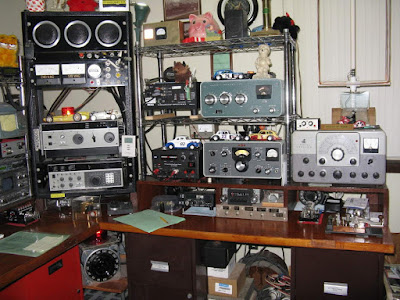 |
| WB2WGX in New York |
Worked on both 40 and 15m was Paul, WB5EVO in OK. Putting yet another DX-60 into the log with the notation of "599+"!
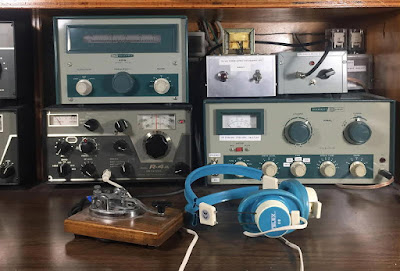 |
| WB5EVO in Oklahoma |
What would 15m be without a little DX? I was delighted to hear Jorge, KP4GC in PR, reply to my CQ to the south east. Jorge was heard working stations from coast to coast but may have also been living too close to the NRR edge as the bias supply in his Hallicrafters HT-37 took him off the air until he set up his Kenwood TS-520 for the duration.
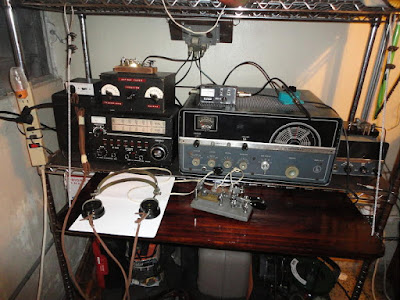 |
| KP4GC in Puerto Rico |
Another duo-band contact (40 & 15m) was with Dan, K2YWE in MD whose Globe Scout was also 599, three S-units louder than on 40m.
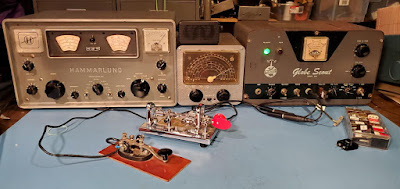 |
| K2YWE in Maryland |
Although 15m provided a lot of excitement, most of my contacts were on 40m. Number 1 on the runway again this year was NRR regular, WB2AWQ down in Reno. Howie's fine homebrew parallel 807s were smoking-in up here, delightfully chirpy, in broad daylight.
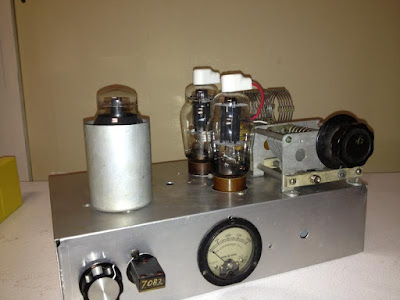 |
| WB2AWQ in Nevada |
George, KA3JWJ in PA impressed again this year on 40m when his original Ameco AC-1 at 8W pushed the S-meter on my FT-1000 to S7.5! How do you do it George? Don't be fooled by that innocent-looking box sitting atop his S-38 inhaler, also used during our QSO. I thought our contact would likely hold up as the contest highlight for me, until later ...
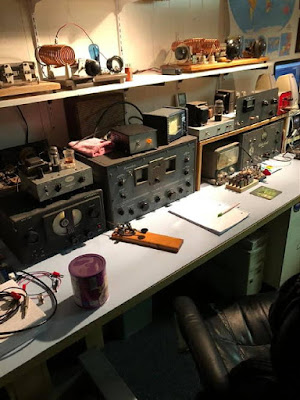 |
| KA3JWJ in Pennsylvania |
WB2QLL, Pete in WI, surprised me on 80m with a ‘never before heard’ (by me) Harvey Wells TBS-50D Bandmaster at 20W out. These once popular transmitters promised buyers 80 - 2m operation, push-pull 6L6 plate modulation and a sturdy 807 final.
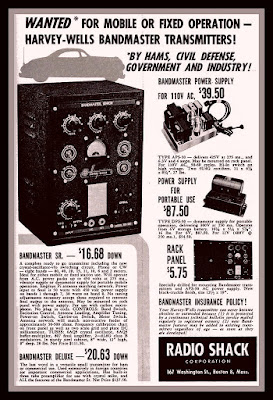 |
| Harvey-Wells 'Bandmasters' |
This was another contest highlight for sure, as I’ve always wondered how these rigs sounded on CW ... and Pete’s signal did not disappoint! It definitely has an identifiable sound.
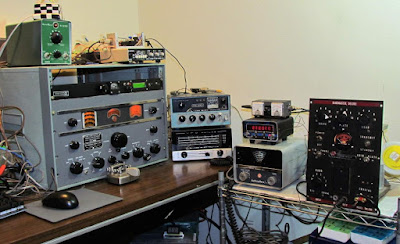 |
| W2QLL in Wisconsin |
Many of you worked NRR devotee VA7MM, whose 100’ high dipoles and DX-60 swept-up an impressive 146 contacts. Well done Mark!
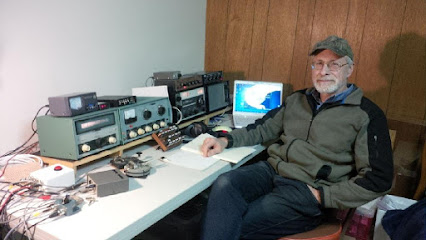 |
| Mark - VA7MM in British Columbia |
Not too far from him was another Mark from BC, VE7CA, who ran his rebuilt Ranger and much-modified HQ-120 on the low bands while his beautiful Drake twins carried the mail on 15m. His well-performing all-wire arrays are supported by a handy selection of tall backyard Firs.
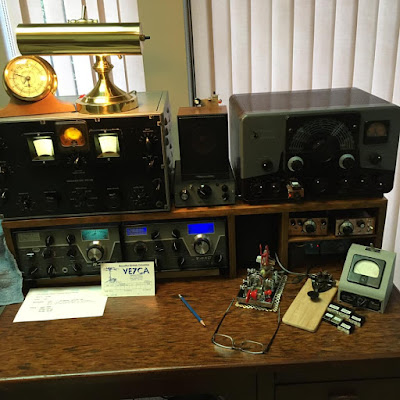 |
| VE7CA in British Columbia |
'579' reports were exchanged on 80m with Tim, K9SB in IL, who was using a Johnson Adventurer and Hallicrafters SX-101A.
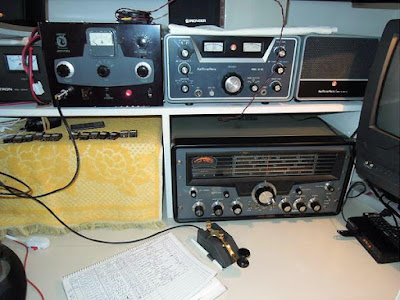 |
| K9SB in Illinois |
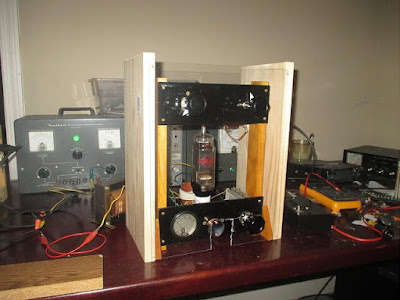 |
| KØSM's '36 Tri-Tet |
Andy's Tri-Tet runs at 400V on the plate, unlike the original design that called for 1kV on the plate and bare tank coil. Now that's really operating on the scary edge! At 8W output on 80 and 40, there's plenty of power to work with.
But it wasn’t just working Andy on 80 and 40 that made it so special as Andy later, tripling from 40, finessed this little beast up to the 15m ultra-highs, making it to the west coast in fine shape. It was delightful to hear the '36 Tri-Tet's charming chirp on a band that didn’t even exist when this rig was first thought of. Thanks for the fun Andy!
 |
| Andy - KØSM in New York |
For many more station photos and 'soapbox' comments from this year's participants, be sure to visit the NRR Soapbox page and ... if you didn't make this year's event then now's the time to start planning for the 2022 NRR ... see you all then!
Steve McDonald, VE7SL, is a regular contributor to AmateurRadio.com and writes from British Columbia, Canada. Contact him at [email protected].
 The Endurance of CW in Amateur Radio
The Endurance of CW in Amateur Radio
CW Spans a Century
What other modes have remained as popular standards using standard ham equipment and continuously in use by amateur radio operators as CW?
Richard Carpenter, AA4OO, is a regular contributor to AmateurRadio.com and writes from North Carolina, USA. Contact him at [email protected].
 LHS Episode #401: The Weekender LXVIII
LHS Episode #401: The Weekender LXVIII
It's time once again for The Weekender. This is our bi-weekly departure into the world of amateur radio contests, open source conventions, special events, listener challenges, hedonism and just plain fun. Thanks for listening and, if you happen to get a chance, feel free to call us or e-mail and send us some feedback. Tell us how we're doing. We'd love to hear from you.
73 de The LHS Crew
Russ Woodman, K5TUX, co-hosts the Linux in the Ham Shack podcast which is available for download in both MP3 and OGG audio format. Contact him at [email protected].

